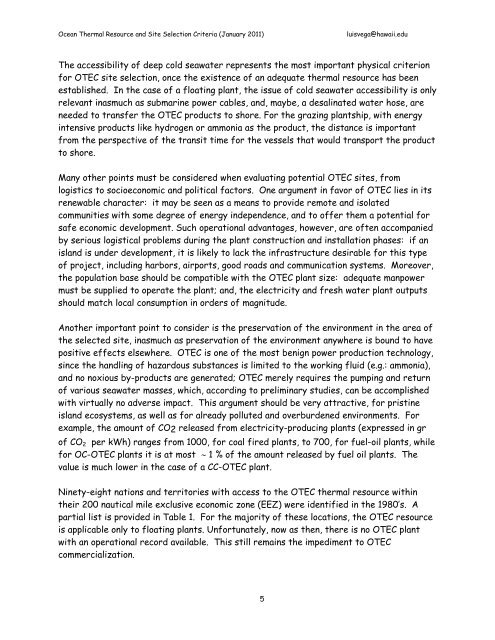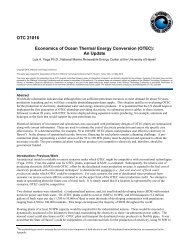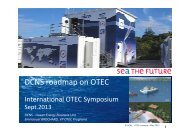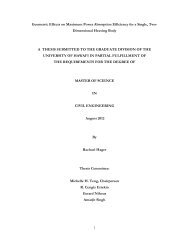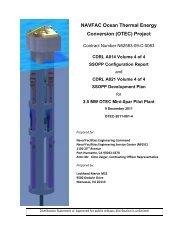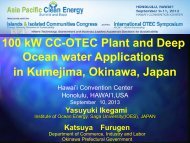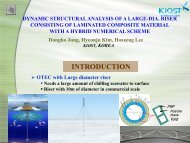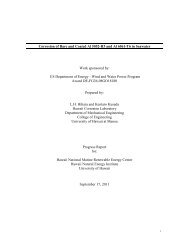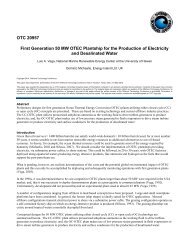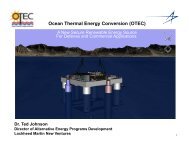Ocean Thermal Resources and OTEC Site Selection Criteria
Ocean Thermal Resources and OTEC Site Selection Criteria
Ocean Thermal Resources and OTEC Site Selection Criteria
You also want an ePaper? Increase the reach of your titles
YUMPU automatically turns print PDFs into web optimized ePapers that Google loves.
<strong>Ocean</strong> <strong>Thermal</strong> Resource <strong>and</strong> <strong>Site</strong> <strong>Selection</strong> <strong>Criteria</strong> (January 2011) luisvega@hawaii.edu<br />
The accessibility of deep cold seawater represents the most important physical criterion<br />
for <strong>OTEC</strong> site selection, once the existence of an adequate thermal resource has been<br />
established. In the case of a floating plant, the issue of cold seawater accessibility is only<br />
relevant inasmuch as submarine power cables, <strong>and</strong>, maybe, a desalinated water hose, are<br />
needed to transfer the <strong>OTEC</strong> products to shore. For the grazing plantship, with energy<br />
intensive products like hydrogen or ammonia as the product, the distance is important<br />
from the perspective of the transit time for the vessels that would transport the product<br />
to shore.<br />
Many other points must be considered when evaluating potential <strong>OTEC</strong> sites, from<br />
logistics to socioeconomic <strong>and</strong> political factors. One argument in favor of <strong>OTEC</strong> lies in its<br />
renewable character: it may be seen as a means to provide remote <strong>and</strong> isolated<br />
communities with some degree of energy independence, <strong>and</strong> to offer them a potential for<br />
safe economic development. Such operational advantages, however, are often accompanied<br />
by serious logistical problems during the plant construction <strong>and</strong> installation phases: if an<br />
isl<strong>and</strong> is under development, it is likely to lack the infrastructure desirable for this type<br />
of project, including harbors, airports, good roads <strong>and</strong> communication systems. Moreover,<br />
the population base should be compatible with the <strong>OTEC</strong> plant size: adequate manpower<br />
must be supplied to operate the plant; <strong>and</strong>, the electricity <strong>and</strong> fresh water plant outputs<br />
should match local consumption in orders of magnitude.<br />
Another important point to consider is the preservation of the environment in the area of<br />
the selected site, inasmuch as preservation of the environment anywhere is bound to have<br />
positive effects elsewhere. <strong>OTEC</strong> is one of the most benign power production technology,<br />
since the h<strong>and</strong>ling of hazardous substances is limited to the working fluid (e.g.: ammonia),<br />
<strong>and</strong> no noxious by-products are generated; <strong>OTEC</strong> merely requires the pumping <strong>and</strong> return<br />
of various seawater masses, which, according to preliminary studies, can be accomplished<br />
with virtually no adverse impact. This argument should be very attractive, for pristine<br />
isl<strong>and</strong> ecosystems, as well as for already polluted <strong>and</strong> overburdened environments. For<br />
example, the amount of CO2 released from electricity-producing plants (expressed in gr<br />
of CO2 per kWh) ranges from 1000, for coal fired plants, to 700, for fuel-oil plants, while<br />
for OC-<strong>OTEC</strong> plants it is at most ∼ 1 % of the amount released by fuel oil plants. The<br />
value is much lower in the case of a CC-<strong>OTEC</strong> plant.<br />
Ninety-eight nations <strong>and</strong> territories with access to the <strong>OTEC</strong> thermal resource within<br />
their 200 nautical mile exclusive economic zone (EEZ) were identified in the 1980’s. A<br />
partial list is provided in Table 1. For the majority of these locations, the <strong>OTEC</strong> resource<br />
is applicable only to floating plants. Unfortunately, now as then, there is no <strong>OTEC</strong> plant<br />
with an operational record available. This still remains the impediment to <strong>OTEC</strong><br />
commercialization.<br />
5


